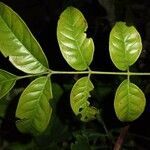Shrubs or small trees, 2–6(–9) m tall, sometimes ± subscandent. Bark smooth, mottled, finely lenticellate; hard, white to slightly pink, odourless and tasteless (Elmer). Leafy twigs 3–5 mm diam., lenticellate, ±finely pubescent, sericeous at apex. Leaves 10–28 cm long; paler abaxially, petiole to 6 cm, terete, pubescent. Leaflets 4–6(–7) on each side, opposite, 2–11 by 1.5–4 cm, narrowly oblong to ovate, entire or irregularly dentate owards apex, ± pubescent on both surfaces at least on veins, but especially abaxially; apex acuminate; base weakly asymmetric, acute or rarely ± rounded; veins c. 6–9 on each side, arcuate, prominent abaxially; petiolule to 8 mm (-2 cm in apical leaflet), or absent. Thyrses 8–21 cm long, branched at apex of rachis 4–12 cm long, ascendant, silky pubescent; bracts 1.5 mm long, subulate, sericeous; bracteoles c. 1 mm, sericeous; pseudopedicel c. 3 mm, sericeous. Calyx lobes c. 1 mm long, triangular, spreading, pubescent, persistent in fruit. Petals 3.5–4 mm long, ovate, greenish or cream to white, densely pubescent without. Filaments 1.5–2.5 mm long, anthers yellow. Ovary 5–6-angular, glabrous, style c. 0.7 mm, glabrous. Drupe c. 5 mm diam., longitudinally grooved, reddish brown. 2n = 28, 56.
A shrub. It grows to 1-5 m high. The leaflets along the stalk end with a leaflet at the end. The leaflets have short stalks. Leaflets are hairy on the upper surface. The flowers are small and green. They occur in the axils of leaves. The fruit are purple to black when ripe. They are round and 4-5 mm across.


